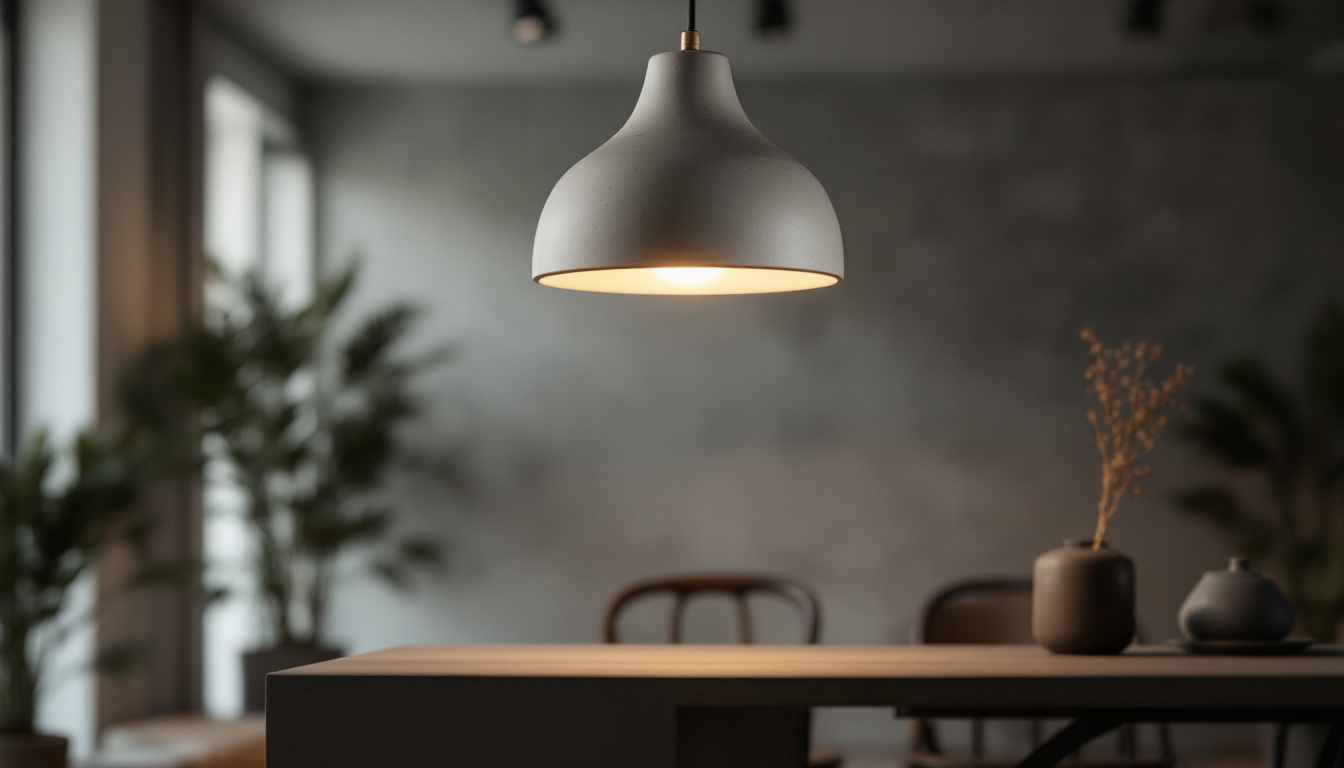
In the ever-evolving world of interior design, lighting plays a pivotal role in shaping spaces and influencing moods. Among the myriad of lighting options available, concrete pendant lamps have emerged as a distinctive choice that combines functionality with aesthetic appeal. For lighting contractors, understanding the significance of these fixtures can enhance their offerings and elevate their projects. This article delves into the various aspects of concrete pendant lamps and their importance for lighting contractors.
Concrete pendant lamps are lighting fixtures made primarily from concrete, often featuring a minimalist design that complements modern and industrial aesthetics. Their unique material not only provides durability but also offers a variety of textures and finishes that can enhance a space’s overall look.
The use of concrete as a primary material in pendant lamps allows for a diverse range of designs. From sleek, smooth finishes to rough, textured surfaces, concrete can be molded into various shapes, making it a versatile choice for different decor styles. This adaptability is crucial for lighting contractors who aim to meet the specific needs of their clients.
Moreover, concrete’s neutral tone can blend seamlessly with other materials, such as wood, metal, or glass. This characteristic enables lighting contractors to create harmonious environments, regardless of the existing decor. The ability to customize concrete pendant lamps further enhances their appeal, allowing contractors to offer bespoke solutions tailored to individual client preferences. For instance, some designers incorporate colored pigments or even embedded materials like stones or metals into the concrete mix, resulting in one-of-a-kind pieces that serve as both lighting and art. This creative freedom not only elevates the aesthetic value of the lamps but also allows them to become focal points in any room.
Concrete pendant lamps are not only aesthetically pleasing but also functional. They can be used in various settings, from residential spaces to commercial establishments. Their ability to provide focused lighting makes them ideal for kitchen islands, dining areas, and workspace environments.
Additionally, the versatility of concrete pendant lamps extends to their compatibility with different light sources. Whether it’s incandescent, LED, or fluorescent bulbs, these fixtures can accommodate various lighting technologies, allowing contractors to offer energy-efficient solutions without compromising on style. Furthermore, many modern concrete pendant designs incorporate adjustable features, such as dimmable settings or movable arms, enabling users to customize the intensity and direction of light according to their specific needs. This functionality makes them particularly appealing for dynamic spaces where lighting requirements may change throughout the day, such as in open-concept living areas or bustling cafes.
The aesthetic qualities of concrete pendant lamps cannot be overstated. Their raw, industrial look appeals to a wide range of design sensibilities, particularly in contemporary and urban settings. For lighting contractors, understanding the aesthetic impact of these fixtures is essential for creating visually striking spaces.
Concrete pendant lamps can enhance various design styles, from mid-century modern to rustic chic. Their minimalist design allows them to fit seamlessly into diverse environments, making them a valuable addition to any lighting contractor’s portfolio.
In modern settings, concrete pendant lamps can serve as statement pieces, drawing attention while maintaining a subtle elegance. In contrast, in more traditional or eclectic spaces, they can provide an unexpected twist, adding character and depth to the overall design. The versatility of concrete also allows for various finishes and textures, from smooth and polished to rough and raw, further expanding their compatibility with different aesthetics. For example, a polished concrete lamp can complement sleek, contemporary furniture, while a rough-hewn version might harmonize beautifully with reclaimed wood accents in a rustic setting.
Lighting is a crucial element in setting the mood of a space. Concrete pendant lamps can create a warm and inviting atmosphere, especially when paired with the right light bulbs. The way concrete diffuses light can add a soft glow, enhancing the overall ambiance of a room.
For lighting contractors, understanding how to manipulate light with concrete fixtures is vital. By selecting the appropriate wattage and bulb type, contractors can help clients achieve their desired ambiance, whether it’s a cozy dining experience or a vibrant workspace. Additionally, the strategic placement of these lamps can dramatically alter a room’s dynamics; for instance, hanging them at varying heights can create visual interest and depth, while clustering multiple fixtures can form a stunning focal point. This adaptability not only showcases the beauty of the concrete itself but also allows for creative expression in lighting design, making each installation unique to the space it inhabits.
Incorporating concrete pendant lamps into lighting designs offers several benefits that lighting contractors should consider. These advantages not only enhance the aesthetic appeal of a space but also contribute to the overall functionality and efficiency of lighting solutions.
One of the most significant advantages of concrete pendant lamps is their durability. Concrete is a robust material that can withstand wear and tear, making these fixtures an excellent long-term investment for clients. For lighting contractors, recommending durable products can lead to increased client satisfaction and repeat business.
Furthermore, the longevity of concrete pendant lamps means that clients are less likely to need replacements or repairs, reducing long-term costs. This aspect can be a selling point for contractors when discussing options with potential clients. Additionally, concrete’s natural resistance to moisture and humidity makes it an ideal choice for various environments, including kitchens and bathrooms, where other materials might deteriorate over time. This versatility allows contractors to confidently suggest concrete fixtures in a wider range of settings, ensuring that their clients receive both style and substance.
With the growing emphasis on sustainability and energy efficiency, concrete pendant lamps can be designed to accommodate energy-efficient lighting technologies, such as LED bulbs. These bulbs consume less energy and have a longer lifespan compared to traditional incandescent options, making them an eco-friendly choice.
Lighting contractors can leverage this trend by promoting the energy-saving benefits of concrete pendant lamps. By providing clients with sustainable options, contractors not only contribute to environmental conservation but also align with the increasing demand for energy-efficient solutions. Moreover, the ability to integrate smart lighting systems with concrete fixtures can further enhance energy efficiency. By utilizing smart technology, clients can control their lighting remotely, set schedules, and even adjust brightness levels, leading to significant energy savings and a more personalized lighting experience. This modern approach not only appeals to tech-savvy clients but also positions contractors as forward-thinking professionals in a competitive market.
While concrete pendant lamps offer numerous benefits, there are specific installation considerations that lighting contractors must keep in mind. Proper installation is crucial to ensure safety, functionality, and aesthetic appeal.
Concrete pendant lamps can be significantly heavier than their counterparts made from lighter materials. Therefore, contractors must ensure that the mounting hardware and ceiling support can adequately bear the weight of the fixture. This consideration is particularly important in residential settings where ceiling structures may vary.
Additionally, it is essential to follow local building codes and regulations when installing concrete pendant lamps. Ensuring compliance not only guarantees safety but also protects contractors from potential liabilities.
When installing concrete pendant lamps, lighting contractors must also pay attention to wiring and electrical connections. Proper wiring techniques are essential to prevent electrical hazards and ensure the longevity of the fixture.
Contractors should be familiar with the specific electrical requirements of the chosen light source, as well as the compatibility of the fixture with existing electrical systems. This knowledge will enable them to provide clients with safe and efficient lighting solutions.
As the design landscape continues to evolve, staying informed about market trends and client preferences is essential for lighting contractors. Understanding what clients are looking for in lighting solutions can help contractors tailor their offerings and stay competitive.
The industrial design trend has gained significant traction in recent years, with many clients seeking to incorporate raw materials and minimalist aesthetics into their spaces. Concrete pendant lamps align perfectly with this trend, making them a sought-after choice for both residential and commercial projects.
By recognizing the appeal of industrial design, lighting contractors can position concrete pendant lamps as a go-to option for clients looking to achieve a modern, urban feel in their spaces.
Today’s clients are increasingly interested in personalized design solutions that reflect their individual tastes and lifestyles. Concrete pendant lamps offer a unique opportunity for customization, allowing contractors to work closely with clients to create bespoke fixtures that align with their vision.
Whether it’s selecting specific finishes, colors, or shapes, the ability to customize concrete pendant lamps can set contractors apart from competitors. This focus on personalization can lead to increased client satisfaction and loyalty.
Concrete pendant lamps represent a significant opportunity for lighting contractors to enhance their offerings and meet the evolving needs of clients. With their unique material, aesthetic appeal, and functional benefits, these fixtures can elevate any space while providing durability and energy efficiency.
By understanding the importance of concrete pendant lamps, lighting contractors can better position themselves in the market, cater to client preferences, and create stunning lighting designs that leave a lasting impression. As the demand for innovative lighting solutions continues to grow, embracing the potential of concrete pendant lamps is a strategic move that can lead to success in the competitive lighting industry.
Ready to take your lighting designs to the next level with concrete pendant lamps? At LumenWholesale, we provide lighting contractors with an exceptional range of high-quality, spec-grade lighting products at the most competitive wholesale prices. Say goodbye to local distributor markups and hello to a curated selection that meets the highest industry standards. With the added convenience of free shipping on bulk orders, LumenWholesale is your go-to source for premium lighting solutions that combine quality, affordability, and convenience. Elevate your projects and impress your clients by choosing Wholesale Lighting at the Best Value today.

Explore the essential power tools for lighting contractors in this insightful article.

Discover how E12 B Type bulbs can streamline projects for lighting contractors.

Discover how to future-proof your lighting projects with LED ceiling light fixtures.

Discover the essential strategies and techniques that lighting contractors need to excel in their field.